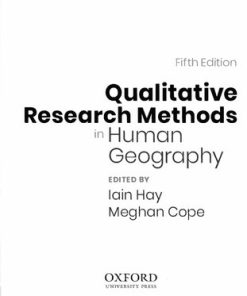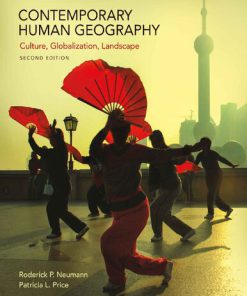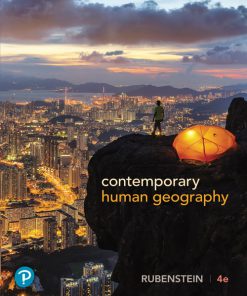Contemporary Human Geography 5th Edition by James M Rubenstein ISBN 9780137631704 0137631707
$50.00 Original price was: $50.00.$25.00Current price is: $25.00.
Contemporary Human Geography 5th Edition by James M Rubenstein – Ebook PDF Instant Download/Delivery: 9780137631704 ,0137631707
Full download Contemporary Human Geography 5th Edition after payment

Product details:
ISBN 10: 0137631707
ISBN 13: 9780137631704
Author: James M Rubenstein
Contemporary Human Geography 5th Edition Table of contents:
Chapter 1 This is Geography
1.1 Key Issue 1 Why is geography a science?
Welcome to Geography
1.1.1 Comparing Geography & History
Contrasting Geography & History
1.1.2 Geographers Explain Where & Why
Geography’s Basic Concepts & COVID-19
1.2 Key Issue 1 Why is geography a science?
Contemporary Geographic Tools
1.2.1 What Is a Map?
GIScience: Analyzing Data
1.2.2 GPS: Pinpointing Locations
VGI: Collecting & Sharing Data
Geocode System: What3words
1.3 Key Issue 1 Why is geography a science?
Making Maps
1.3.1 Geography in the Ancient World
Geography’s Revival
1.3.2 Types of Maps
1.4 Key Issue 1 Why is geography a science?
The Geographic Grid
1.4.1 Longitude & Latitude
Telling Time
1.4.2 Scale & Projection
Map Scale
Projection
1.5 Key Issue 2 Why is every place unique?
Place: A Unique Location
1.5.1 Location
Place Names
1.5.2 Site & Situation
Site
Situation
1.6 Key Issue 2 Why is every place unique?
Region: A Unique Area
1.6.1 Three Types of Regions
Formal Region
1.6.2 Functional & Vernacular Regions
Functional Region
Vernacular Region
1.7 Key Issue 3 Why are different places similar?
Scale: From Global to Local
1.7.1 Globalization of Culture & the Economy
Globalization of Culture
Globalization of the Economy
1.7.2 Local Diversity
Spatial Association
1.8 Key Issue 3 Why are different places similar?
Space: Distribution of Features
1.8.1 Distribution Properties: Density
Distribution Properties: Concentration
Distribution Properties: Pattern
1.8.2 Distribution Properties
Distribution: Social Distance
Distribution: Major League Baseball
1.9 Key Issue 3 Why are different places similar?
Space: Identity
1.9.1 Distribution by Ethnicity
Black Lives Matter
1.9.2 Distribution by Sexual Orientation
Distribution: United States
Distribution: Worldwide
1.10 Key Issue 3 Why are different places similar?
Space: Inequality
1.10.1 Inequality: Gender
Distribution by Gender
1.10.2 Uneven Development
Inequality Among Countries
Inequality Within Countries
1.11 Key Issue 4 Why are places connected?
Connection: Diffusion & Interaction
1.11.1 Types of Diffusion
Relocation Diffusion
Expansion Diffusion
1.11.2 Spatial Interaction
Connections & Culture
Networks
1.12 Key Issue 4 Why are places connected?
Connection: Sustainability
1.12.1 Three Pillars of Sustainability
Three Pillars: The Everglades
1.12.2 Ecology & Ecosystems
Earth’s Connected Physical Systems
1.13 Key Issue 4 Why are places connected?
Humans & Their Environment
1.13.1 Possibilism
Sustainable Ecosystem: The Netherlands
1.13.2 A Sustainability Doughnut
Surging Seas
Chapter 1 Review, Analyze, & Apply
Key Issue 1 Why Is Geography a Science?
Key Issue 2 Why Is Every Place Unique?
Key Issue 3 Why Are Different Places Similar?
Key Issue 4 Why Are Places Connected?
Key Terms
Geospatial Analysis
Environmental Challenges for the Dutch
Explore Dili
Chapter 2 Population & Health
2.1 Key Issue 1 Where are people distributed?
Population Density
2.1.1 Density
Arithmetic Density
2.1.2 Physiological Density
Agricultural Density
2.2 Key Issue 1 Where are people distributed?
Population Concentrations
2.2.1 Population Clusters
Sparsely Populated Areas
2.2.2 Population Portions
Population Cartogram
Ecumene
2.3 Key Issue 2 Why is population increasing?
Population Change
2.3.1 Population Growth Through History
Natural Increase Rate
2.3.2 Fertility
Mortality
2.4 Key Issue 2 Why is population increasing?
The Demographic Transition
2.4.1 Demographic Transition: Overview
Demographic Transition: Stage 1
Demographic Transition: Stage 2
2.4.2 Demographic Transition: Stage 3
Demographic Transition: Stage 4
2.5 Key Issue 3 How does health vary by region?
Aging & Health
2.5.1 Countries with Many Young People
Infant Mortality
2.5.2 Countries with Many Older People
Population Pyramids
2.6 Key Issue 3 How does health vary by region?
Gender & Health
2.6.1 Mothers at Risk
Mothers at Risk: United States
2.6.2 Baby Girls at Risk
2.7 Key Issue 3 How does health vary by region?
Medical Services
2.7.1 Hospital Beds
Physicians
2.7.2 Health-Care Expenditures
Government Expenditures on Health Care
2.8 Key Issue 3 How does health vary by region?
Epidemiologic Transition
2.8.1 Epidemiologic Transition, Stages 1 & 2
2.8.2 Epidemiologic Transition, Stages 3 & 4
2.9 Key Issue 4 Why might population change in the future?
Population Futures
2.9.1 Possible Demographic Transition Stage 5
Total Fertility Rate
2.9.2 Possible Stage 5 Countries
Pronatalist & Antinatalist Policies
2.10 Key Issue 4 Why might population change in the future?
Family Futures
2.10.1 Declining CBR
Lowering CBR Through Education & Health Care
2.10.2 Lowering CBR Through Contraception
Family Planning Methods
2.11 Key Issue 4 Why might population change in the future?
Epidemiologic Futures
2.11.1 Reason for Possible Stage 5: Diffusion
Global Distribution
2.11.2 Reason for Possible Stage 5: Increased Connections
Diffusion of HIV/AIDS in the United States
2.12 Key Issue 4 Why might population change in the future?
Population & Resources
2.12.1 Reason for Possible Stage 5: Evolution
Reason for Possible Stage 5: Poverty
2.12.2 Malthus’s Theory
Malthus’s Critics
Malthus’s Theory & Reality
Chapter 2 Review, Analyze, & Apply
Key Issue 1 Where Are People Distributed?
Key Issue 2 Why Is Population Increasing?
Key Issue 3 How Does Health Vary by Region?
Key Issue 4 Why Might Population Change in the Future?
Explore Nagel-Gulab, Egypt
Key Terms
Geospatial Analysis
Obesity & Income
Chapter 3 Migration
3.1 Key Issue 1 Where are migrants distributed?
Migration Principles
3.1.1 Migration “Laws”
Migration Transition
3.1.2 International & Internal Migration
International Migration
Internal Migration
3.2 Key Issue 1 Where are migrants distributed?
Global Migration Distribution
3.2.1 Net Migration
Origin & Destination
3.2.2 Changing U.S. Immigration
Colonial Immigration
Nineteenth-Century Immigration
Recent Immigration
3.3 Key Issue 2 Where do people migrate within countries?
Interregional Migration
3.3.1 Interregional Migration: United States
A Changing U.S. Population Center
3.3.2 Interregional Migration: Developed Countries
Interregional Migration: Canada
Interregional Migration: Europe
3.4 Key Issue 2 Where do people migrate within countries?
Intraregional Migration
3.4.1 From Rural to Urban Areas
From Urban to Suburban Areas
3.4.2 From Urban to Rural Areas
Reasons for Decreasing Intraregional Migration
3.5 Key Issue 3 Why do people migrate?
Reasons for Migrating
3.5.1 Who Are the Migrants?
Age of Migrants
Female & Male Migrants
3.5.2 Environmental Reasons for Migrating
Attractive Environments
Flooding & Migration
Rising Seas & Migration
3.6 Key Issue 3 Why do people migrate?
Economic Reasons for Migrating
3.6.1 Economic Destinations
Working Conditions
3.6.2 Remittances
Changing Attraction
3.7 Key Issue 3 Why do people migrate?
Political Reasons for Migrating
3.7.1 Forced Migration of Native Americans
Intervening Obstacles
3.7.2 Forced Political Migration
The Largest Numbers of Refugees
3.8 Key Issue 4 What challenges do migrants face?
Government Migration Policies
3.8.1 Classifying Immigration & Emigration Policies
Distribution of Immigration & Emigration Policies
3.8.2 Europe’s Immigration Issues
Open Borders Within Europe
Guest Workers
3.9 Key Issue 4 What challenges do migrants face?
U.S. Immigration Policies
3.9.1 U.S. Quotas
Quota Preferences
3.9.2 Unauthorized Immigration
Who Are the Unauthorized Immigrants?
3.10 Key Issue 4 What challenges do migrants face?
U.S.–Mexico Border
3.10.1 Along the U.S.–Mexico Border
Divided Americans
3.10.2 Diverse Border Crossings
Chapter 3 Review, Analyze, & Apply
Key Issue 1 Where Are Migrants Distributed?
Key Issue 2 Where Do People Migrate Within Countries?
Key Issue 3 Why Do People Migrate?
Key Issue 4 What Challenges Do Migrants Face?
Explore Mexico’s Other Border
Key Terms
Geospatial Analysis
Europe’s Immigrants & Emigrants
Chapter 4 Culture & Social Media
4.1 Key Issue 1 How are leisure activities distributed?
Material Culture & Geography
4.1.1 Scale & Types of Culture
Origin
Distribution
4.1.2 Diffusion of U.S. Houses
Relocation Diffusion of U.S. Folk Houses
Expansion Diffusion of U.S. Popular Housing
4.2 Key Issue 1 How are leisure activities distributed?
Popular & Folk Food Customs
4.2.1 Popular Food Culture
Regional Differences in Popular Food Culture
4.2.2 Folk Food Customs
Food Taboos
4.3 Key Issue 1 How are leisure activities distributed?
Distribution of Electronic Communications
4.3.1 Distribution of Smartphones
Cell Phones in Africa
4.3.2 Distribution of Social Media Platforms
Regional Differences in Popularity
4.4 Key Issue 2 How does culture diffuse?
Diffusion of Clothing
4.4.1 Folk Clothing Preferences
The Amish
4.4.2 Distribution of Popular Clothing Styles
Jeans
4.5 Key Issue 2 How does culture diffuse?
Diffusion of Music
4.5.1 Folk Music
Folk Songs: Vietnam
4.5.2 Popular Music
Popular Music Clusters
Regional Variations
4.6 Key Issue 2 How does culture diffuse?
Diffusion of Sports
4.6.1 Soccer’s Folk Culture Origins
Soccer as Popular Culture
4.6.2 Regionally Distinctive Sports
Olympic Sports
4.7 Key Issue 3 Why is access to culture unequal?
Electronic Diffusion of Culture
4.7.1 Diffusion of TV: Mid-Twentieth Century
Streaming Services
4.7.2 Diffusion of the Internet: Late Twentieth Century
Comparing the Diffusion of TV & the Internet
4.8 Key Issue 3 Why is access to culture unequal?
Challenges in Accessing Electronic Media
4.8.1 Freedom on the Net
Banned Technology
4.8.2 Blocked Content
Violated User Rights
4.9 Key Issue 3 Why is access to culture unequal?
Spatial Dimensions to Cyberattacks
4.9.1 Cyberattacks
Fake News & Alternative Facts
4.9.2 Victims of Cyberattacks
Malware
Cyber Espionage
Ransomware
Using Our Personal Data
4.10 Key Issue 4 Why do cultures face sustainability challenges?
Maintaining Unique Folk Culture Landscapes
4.10.1 Maintaining Unique Folk Culture
Marriage in India: Challenging Cultural Values
4.10.2 Maintaining Unique Food Customs
Terroir
Wine Geography
4.11 Key Issue 4 Why do cultures face sustainability challenges?
Uniform Landscapes of Popular Culture
4.11.1 Travel
Overtourism
4.11.2 Unsustainable Landscapes
Skiing in Dubai
Golf
Chapter 4 Review, Analyze, & Apply
Key Issue 1 How Are Leisure Activities Distributed?
Key Issue 2 How Does Culture Diffuse?
Key Issue 3 Why Is Access to Culture Unequal?
Key Issue 4 Why Do Cultures Face Sustainability Challenges?
Key Terms
Geospatial Analysis
Connectivity in Sub-Saharan Africa
Explore Ski Dubai
Chapter 5 Languages
5.1 Key Issue 1 How are languages distributed?
Classifying Languages
5.1.1 Introducing Languages
Organizing Languages
5.1.2 Language Families
5.2 Key Issue 1 How are languages distributed?
Distribution of Languages
5.2.1 Writing Systems
5.2.2 Distribution of Language Families
Asian Language Families
African Language Families
5.3 Key Issue 1 How are languages distributed?
Distribution of Indo-European Languages
5.3.1 Asia’s Indo-European Branch
5.3.2 Europe’s Indo-European Branches
Romance Branch
Germanic Branch
Balto-Slavic Branch
5.4 Key Issue 2 How do languages diffuse?
Into & Out of Africa
5.4.1 Early Diffusion of a Language
Possible Origin of Languages
5.4.2 Common Ancestry of Indo-European
Nomadic Warrior Theory
Sedentary Farmer Theory
5.5 Key Issue 2 How do languages diffuse?
Origin & Diffusion of English
5.5.1 Origin of English
Contemporary Distribution of English
5.5.2 Sharing Languages
Lingua Franca
English on the Internet
Chinese: The Next Lingua Franca?
5.6 Key Issue 3 How do languages vary among places?
Dialects
5.6.1 American & British English
Dialects in the United Kingdom
5.6.2 U.S. Dialects
Changing Distribution of U.S. Dialects
5.7 Key Issue 3 How do languages vary among places?
Dialect or Language?
5.7.1 Creole Languages
Informal Languages
Dialects Become Languages
5.7.2 Sign Languages
Gender Differences in Languages
Language Diversity
5.8 Key Issue 3 How do languages vary among places?
Multilingual Countries
5.8.1 Multilingual Countries in Europe
5.8.2 Other Multilingual Countries
5.9 Key Issue 4 Why do languages survive or perish?
Endangered & Extinct Languages
5.9.1 Endangered Languages
Distribution of Endangered Languages
5.9.2 Extinct Languages
Extinct Languages in the United States
5.10 Key Issue 4 Why do languages survive or perish?
Preserving & Reviving Languages
5.10.1 Preserving Languages
Brythonic Celtic
Goidelic Celtic
5.10.2 Reviving Languages
Inventing Languages
Chapter 5 Review, Analyze, & Apply
Key Issue 1 How Are Languages Distributed?
Key Issue 2 How Do Languages Diffuse?
Key Issue 3 How Do Languages Vary Among Places?
Key Issue 4 Why Do Languages Survive or Perish?
Key Terms
Geospatial Analysis
South America’s Indigenous Languages
Explore Multilingual Belgium
Chapter 6 Religions
6.1 Key Issue 1 Where are religions distributed?
Distribution of Religions
6.1.1 Religions & Geography
Classifying Religions
6.1.2 Regional Diversity of Religions
6.2 Key Issue 1 Where are religions distributed?
Distribution of Christians
6.2.1 Branches of Christianity
Distribution of Branches in Europe
6.2.2 Distribution of Christian Branches in the Western Hemisphere
Religions of the United States
6.3 Key Issue 1 Where are religions distributed?
Distribution of Buddhists & Muslims
6.3.1 Foundation of Buddhism
Branches of Buddhism
6.3.2 Distribution of Muslims
Branches of Islam
6.4 Key Issue 1 Where are religions distributed?
Distribution of Ethnic Religions
6.4.1 Clustered Distribution of Ethnic Religions
Distribution of Hindus
Most Popular Hindu Gods
6.4.2 Chinese Folk Religions
Ethno-religions
6.5 Key Issue 1 Where are religions distributed?
Distribution of Other Religions
6.5.1 Religions with at Least 15 million Adherents
6.5.2 Religions with between 3 & 9 Million Adherents
6.6 Key Issue 2 Why do religions have distinctive distributions?
Geographic Origin of Religions
6.6.1 Origin of Hinduism & Buddhism in South Asia
Unknown Date of Origin of Hinduism
Origin of Buddhism in Present-Day Nepal
6.6.2 Origin of Christianity & Islam in Southwest Asia
Origin of Christianity
Origin of Islam
6.7 Key Issue 2 Why do religions have distinctive distributions?
Historical Diffusion of Religions
6.7.1 Early Diffusion of the Three Largest Universalizing Religions
Diffusion of Christianity
6.7.2 Historical Diffusion of Buddhism
Historical Diffusion of Islam
6.8 Key Issue 2 Why do religions have distinctive distributions?
Recent Diffusion of Religions
6.8.1 Religious Composition of Migrants
Migration Patterns of Christians
6.8.2 Migration Patterns of Muslims
Migration Patterns of Jews
6.9 Key Issue 3 How do religions organize space?
Sacred Spaces
6.9.1 Places of Worship
6.9.2 Pilgrimages to Religious Shrines
6.10 Key Issue 3 How do religions organize space?
Religious Settlements & Administration
6.10.1 Utopian Settlements
Religious Place Names
6.10.2 Hierarchical Religions
Locally Autonomous Religions
6.11 Key Issue 3 How do religions organize space?
Religions & the Physical Environment
6.11.1 Cosmogony & Spirits
Hinduism’s South Asian Landscape
6.11.2 The Calendar
Religious Holidays
The Solstice
6.12 Key Issue 4 Why do territorial conflicts arise among religions?
Religions & Social Change
6.12.1 Hinduism & Social Equality
Fundamentalism
6.12.2 Religion & Communism
China, Buddhism, & the Dalai Lama
6.13 Key Issue 4 Why do territorial conflicts arise among religions?
Geographic Perspectives in Israel
6.13.1 Religious Importance
Competing Israeli & Palestinian Perspectives
6.13.2 Jerusalem’s Challenging Geography
Judaism’s Jerusalem
Islam’s Jerusalem
Chapter 6 Review, Analyze, & Apply
Key Issue 1 Where Are Religions Distributed?
Key Issue 2 Why Do Religions Have Distinctive Distributions?
Key Issue 3 How Do Religions Organize Space?
Key Issue 4 Why Do Territorial Conflicts Arise Among Religions?
Key Terms
Geospatial Analysis
South Asia’s Religions
Explore Masjid’s Surroundings
Chapter 7 Ethnicity & Race
7.1 Key Issue 1 Where are ethnicities & races distributed?
Ethnicity, Race, & Nationality
7.1.1 Ethnicities & Geography
Distinguishing Among Ethnicity, Race, & Nationality
7.1.2 Ethnically Complex Brazil
Distribution of Races in Brazil
7.2 Key Issue 1 Where are ethnicities & races distributed?
Distribution of U.S. Ethnicities
7.2.1 Race & the U.S. Census
Distribution of Hispanic Americans
7.2.2 Distribution of Blacks in the United States
Distribution of Asian Americans
Distribution of Indigenous Peoples
7.3 Key Issue 2 Why do ethnicities have distinctive distributions?
Migration Patterns of U.S. Blacks
7.3.1 Forced International Migration of Blacks
7.3.2 Internal Migration of Blacks in the United States
Interregional Migration of Blacks
Intraregional Migration of Blacks
7.4 Key Issue 2 Why do ethnicities have distinctive distributions?
Ethnic & Racial Segregation
7.4.1 “Separate but Equal” in the United States
U.S. Civil Rights Movement
7.4.2 Apartheid in South Africa
Legacy of Apartheid
7.5 Key Issue 2 Why do ethnicities have distinctive distributions?
Black Lives Matter
7.5.1 Racism on the Landscape
Environmental Racism in Flint
7.5.2 Black Lives Matter
Diffusion of BLM
7.6 Key Issue 3 How do ethnicities & nationalities differ?
Ethnicities & Nationalities
7.6.1 Ethnicities & Nationalities in North America
Ethnicities & Nationalities in the British Isles
7.6.2 Nationalism
The Kurds: Ethnicity Without Nationality
Semi-Independent Kurdistan
7.7 Key Issue 3 How do ethnicities & nationalities differ?
Ethnic Diversity in Asia
7.7.1 Ethnic Diversity in Western Asia
7.7.2 Ethnic Diversity in West-Central Asia
Ethnicities in Afghanistan
7.8 Key Issue 4 Why do ethnic cleansing & genocide occur?
Ethnic Cleansing in Asia
7.8.1 Ethnic Cleansing & Genocide
Ethnic Cleansing of Uyghurs
7.8.2 Ethnic Cleansing & Genocide in Myanmar
7.9 Key Issue 4 Why do ethnic cleansing & genocide occur?
Ethnic Cleansing in Africa
7.9.1 Ethnicities & Nationalities in Africa
Ethnic Cleansing in Mali
Ethnic Cleansing in Sudan
7.9.2 Ethnic Cleansing & Genocide in Central Africa
Conflict in Democratic Republic of the Congo
7.10 Key Issue 4 Why do ethnic cleansing & genocide occur?
Ethnic Cleansing in Europe
7.10.1 Ethnic Diversity in Former Yugoslavia
Ethnic Cleansing in Kosovo
7.10.2 Ethnic Cleansing in Bosnia & Herzegovina
Bosnia & Herzegovina After Ethnic Cleansing
Chapter 7 Review, Analyze, & Apply
Key Issue 1 Where Are Ethnicities & Races Distributed?
Key Issue 2 Why Do Ethnicities Have Distinctive Distributions?
Key Issue 3 How Do Ethnicities & Nationalities Differ?
Key Issue 4 Why Do Ethnic Cleansing & Genocide Occur?
Key Terms
Geospatial Analysis
Ethnic Diversity in Sub-Saharan Africa
Explore Lingering Apartheid in South Africa
Chapter 8 Political Geography
8.1 Key Issue 1 Where are states distributed?
A World of States
8.1.1 What Is a State?
The United Nations
8.1.2 Growth of U.N.
8.2 Key Issue 1 Where are states distributed?
Sovereignty of States
8.2.1 Governing States
Trending Away from Unitary States
8.2.2 Cooperation Among European States
Military Cooperation in Europe
Economic Cooperation in Europe
8.3 Key Issue 2 How are states created?
Evolution of States
8.3.1 Ancient States
Roman Empire to Medieval States
8.3.2 Creating Nation-States in Europe
Europe After World War II
8.4 Key Issue 2 How are states created?
New Nation-States
8.4.1 The Nation-State of Slovenia
Nation-States in the Former Soviet Union
8.4.2 Multinational States in the Former Soviet Union
Ukraine
8.5 Key Issue 2 How are states created?
Colonies
8.5.1 Current Colonies
Are These Colonies?
8.5.2 Colonialism
End of Colonialism
8.6 Key Issue 3 Why do states have distinctive boundaries?
Boundaries Between States
8.6.1 Physical Boundaries
The Law of the Sea
8.6.2 Cultural Boundaries
Consequent Boundary: Cyprus
Geometric Boundary: North America
8.7 Key Issue 3 Why do states have distinctive boundaries?
Boundary Disputes
8.7.1 Physical Boundary Dispute
Cultural Boundary Disputes
8.7.2 Boundary Disputes in Polar Regions & Deserts
Polar Regions
Morocco & Sahrawi Arab Republic
8.8 Key Issue 3 Why do states have distinctive boundaries?
Shapes of States
8.8.1 Landlocked States
Compact States: Efficient
Perforated State: South Africa
8.8.2 Prorupted States: Access or Disruption
Elongated States: Potential Isolation
Fragmented States: Problematic
8.9 Key Issue 3 Why do states have distinctive boundaries?
Gerrymandering Boundaries
8.9.1 Gerrymandering
Two Ways to Gerrymander
8.9.2 State Variations in Gerrymandering
8.10 Key Issue 4 What threats do states face?
Terrorism
8.10.1 Defining Terrorism
8.10.2 World Terrorism Trends
Leading Terrorist Organizations
8.11 Key Issue 4 What threats do states face?
States in War & Peace
8.11.1 Regime Types
State Fragility
8.11.2 Nuclear States
Suspect States
Chapter 8 Review, Analyze, & Apply
Key Issue 1 Where Are States Distributed?
Key Issue 2 How Are States Created?
Key Issue 3 Why Do States Have Distinctive Boundaries?
Key Issue 4 What Threats Do States Face?
Explore Europe’s International Boundaries
Key Terms
Geospatial Analysis
Unity & Diversity in Europe
Chapter 9 Food & Agriculture
9.1 Key Issue 1 What do people eat?
How Much We Eat
9.1.1 Food Consumption
Food Security
9.1.2 Undernourishment
Food Waste
Obesity
Food Prices
9.2 Key Issue 1 What do people eat?
Diet
9.2.1 Source of Nutrients
9.2.2 Meat Consumption
Sustainable Food Choices
9.3 Key Issue 2 Where does food come from?
The First Agriculture Revolution
9.3.1 Hunters & Gatherers
Agricultural Revolution
9.3.2 Agriculture Hearths
Diffusion of Agriculture
9.4 Key Issue 2 Where does food come from?
The Second Agricultural Revolution
9.4.1 Subsistence & Commercial Agriculture
9.4.2 Agriculture Regions
Subsistence Agriculture Regions
Intensive Subsistence
Extensive Subsistence
Commercial Agriculture Regions
Intensive Commercial
Extensive Commercial
Agriculture & Climate
9.5 Key Issue 2 Where does food come from?
Comparing Subsistence & Commercial Agriculture
9.5.1 Intensive Subsistence Agriculture
Growing Rice
9.5.2 Intensive Commercial Agriculture
Mixed Crop & Livestock
Dairy Farming
9.6 Key Issue 2 Where does food come from?
The Third Agricultural Revolution
9.6.1 The Green Revolution
Miracle Seeds
9.6.2 Commercial Agriculture Productivity
The von Thünen Model
9.7 Key Issue 3 How has agriculture become more global?
International Trade: Meat
9.7.1 Growth in Agricultural Trade
Livestock Ranching
9.7.2 Fishing
Fish Production
Overfishing
9.8 Key Issue 3 How has agriculture become more global?
Trade in Commercial Crops
9.8.1 Trade in Commercial Crops
9.8.2 Government Policies
Drug Trade
9.9 Key Issue 3 How has agriculture become more global?
Threatened Subsistence Agriculture Practices
9.9.1 Shifting Cultivation
Future of Shifting Cultivation
9.9.2 Pastoral Nomadism
Transhumance
9.10 Key Issue 4 How can agriculture be more Earth-friendly?
Agriculture & Resource Depletion
9.10.1 Loss of Agricultural Land
Urban Growth
9.10.2 Agriculture & Water Supply
Desertification
California Agriculture & Water
9.11 Key Issue 4 How can agriculture be more Earth-friendly?
Biotechnology & Sustainability
9.11.1 Genetically Modified Organisms
GMO Labeling
9.11.2 Organic Farming
Sustainable Land Management
Chapter 9 Review, Analyze, & Apply
Key Issue 1 What Do People Eat?
Key Issue 2 Where Does Food Come From?
Key Issue 3 How Has Agriculture Become More Global?
Key Issue 4 How Can Agriculture Be More Earth-Friendly?
Explore Rice Fields in Asia
Key Terms
Geospatial Analysis
Agriculture & Climate in China
Chapter 10 Development
10.1 Key Issue 1 How does development vary among countries?
Human Development
10.1.1 Development & Geography
Human Development Index
10.1.2 Development Regions
10.2 Key Issue 1 How does development vary among countries?
A Decent Standard of Living
10.2.1 GNI PPP
Share of GNI by Country & Region
10.2.2 Economic Structure
Productivity
10.3 Key Issue 1 How does development vary among countries?
Access to Health & Knowledge
10.3.1 A Long & Healthy Life
Medical Services in Developed & Developing Countries
10.3.2 Access to Knowledge
Other Education Indicators
10.4 Key Issue 2 What inequalities are found in development?
Inequality-Adjusted HDI
10.4.1 Inequality Within a Country
Regional-Scale Inequality
10.4.2 Poverty
Multidimensional Poverty Index (MPI)
Regional Variations in MPI
10.5 Key Issue 2 What inequalities are found in development?
Gender Inequality
10.5.1 Measuring Gender Inequality
Gender Inequality Index (GII)
10.5.2 Components of the GII
Empowerment
Employment
Reproductive Health
10.6 Key Issue 2 What inequalities are found in development?
Gender Development
10.6.1 Gender Development Index
Disparities Between Females & Males
10.6.2 Gender Attitudes
GSNI Dimensions
10.7 Key Issue 3 How do countries become more developed?
Two Paths to Development
10.7.1 Self-Sufficiency Path
Shortcomings of Self-Sufficiency Path
10.7.2 International Trade Path
Rostow’s International Trade Model
The World Trade Organization
10.8 Key Issue 3 How do countries become more developed?
World Trade
10.8.1 International Trade Triumphs
India Moves Away from Self-Sufficiency
10.8.2 Core & Periphery
North–South Split
10.9 Key Issue 3 How do countries become more developed?
Financing Development
10.9.1 Foreign Direct Investment
Principal Lenders
10.9.2 Loan Debt
Austerity Programs
Microfinance for Development
10.10 Key Issue 4 How can development be more sustainable?
Sustainable Development
10.10.1 Sustainable Development Goals
10.10.2 Measuring Progress in Development
Planetary Pressures-Adjusted Human Development Index
10.11 Key Issue 4 How can development be more sustainable?
Fair Trade
10.11.1 Fair Trade
Fair Trade Producer Standards
Cooperatives
10.11.2 Fair Trade Worker Standards
Fair Trade for Bihor
Fair Trade & Consumers
Chapter 10 Review, Analyze, & Apply
Key Issue 1 How Does Development Vary Among Countries?
Key Issue 2 What Inequalities Are Found in Development?
Key Issue 3 How Do Countries Become More Developed?
Key Issue 4 How Can Development Be More Sustainable?
Explore The World’s Lowest HDI
Key Terms
Geospatial Analysis
HDI in Southwest Asia
People also search for Contemporary Human Geography 5th Edition:
contemporary human geography 4th edition pdf
contemporary human geography 4th edition online free
contemporary human geography 4th edition
contemporary human geography 2nd edition pdf
contemporary human geography 2nd edition
You may also like…
Business & Economics - Project Management
Contemporary Project Management: Plan-Driven and Agile Approaches, 5e Timothy Kloppenborg
Earth Sciences
Business & Economics - Management & Leadership
Business & Economics - Investing
How to Invest: Masters on the Craft 1st Edition David M. Rubenstein
Uncategorized
Uncategorized
Politics & Philosophy - General & Miscellaneous Philosophy
Politics & Philosophy
Earth Sciences - Geography
Contemporary Human Geography, 4/e 4th Edition James M. Rubenstein [Rubenstein











